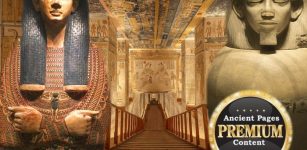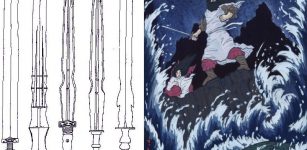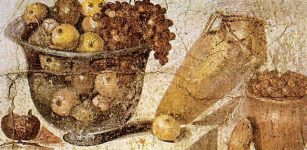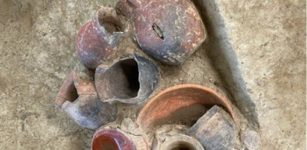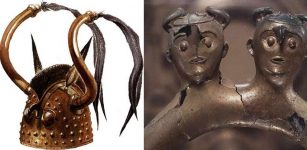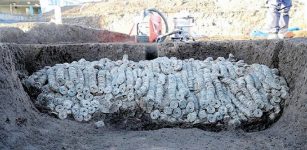Cisterns Unearthed In Metropolis, Turkey Give Insight Into Daily Life Of Its Inhabitants 1,500 Years Ago
Conny Waters - AncientPages.com - Four previously unknown and interconnected cisterns have been unearthed during archaeological excavations carried out at the ancient city of Metropolis, an important city of trade along with Ephesus and Smyrna.
 The ruins of Metropolis have been excavated since 1990. In the ruins of the city, there are traces of early Neolithic as well as Classical, Hellenistic, Roman, Byzantine, and Ottoman periods.
The ruins of Metropolis have been excavated since 1990. In the ruins of the city, there are traces of early Neolithic as well as Classical, Hellenistic, Roman, Byzantine, and Ottoman periods.
Metropolis' ruins are located in modern-day Izmir province in western Turkey, and the city was also known as the “Mother Goddess City” in mythology.
The cisterns, along with the remains of food, animal bones, and pieces of ceramics found in the excavations, have shed new light on the eating habits of ancient residents of the city, located between the Yeniköy and Özbey neighborhoods of Torbalı district in Izmir.
Archaeologists believe that the cisterns - approximately three floors tall and well-preserved - supplied water to the entire settlement on the lower slopes of the acropolis, and particularly to the upper bathhouse structure.
 Left: Four previously unknown cisterns have been discovered in Metropolis in modern-day Izmir province of western Turkey, Dec. 28, 2020. (DHA Photo) Right: The cisterns have been discovered in the acropolis, the Greek citadel built upon the elevated ground in the city, under a 7-meter area filled with earth, Dec. 28, 2020. Image credit: DHA Photo/Müge Yarimbatman
Left: Four previously unknown cisterns have been discovered in Metropolis in modern-day Izmir province of western Turkey, Dec. 28, 2020. (DHA Photo) Right: The cisterns have been discovered in the acropolis, the Greek citadel built upon the elevated ground in the city, under a 7-meter area filled with earth, Dec. 28, 2020. Image credit: DHA Photo/Müge Yarimbatman
Being in this favorable state of preservation, the cisterns offers a unique insight (both archaeological and historical) that will contribute to a better understanding of the daily lives of the city’s ancient dwellers.
“We are excited to open a new door to the daily lives of ancient people that lived in the region 1,500 years ago.
The new discovery of four cisterns in the acropolis prove the skills of the ancient masters of Metropolis in the field of water engineering,” said Professor Serdar Aybek from Manisa Celal Bayar University's Archeology Department. who even earlier led the excavations of Metropolis, as cited by Daily Sabah.
 Numerous glazed ceramic pieces adorned with plant and animal figures have also been discovered in and around the cisterns, Dec. 28, 2020. Image credit: DHA
Numerous glazed ceramic pieces adorned with plant and animal figures have also been discovered in and around the cisterns, Dec. 28, 2020. Image credit: DHA
The cisterns have been discovered in the acropolis, essentially a Greek citadel built on the elevated ground of the city. They were found under a 7-meter (22 ft) area filled with earth.
The four cisterns are thought to have been built in the late Roman and Byzantine period to provide water to the acropolis, located on the highest ground of the city, in the event of a siege, with an estimated total water capacity of 600 tons.
 The four cisterns are thought to have been built in the late Roman period to provide water to the city in the event of a siege. Image credit: DHA
The four cisterns are thought to have been built in the late Roman period to provide water to the city in the event of a siege. Image credit: DHA
The ruins of Metropolis have been excavated since 1990. Apart from the important buildings found in the ancient city life, archaeological excavations contributed with 11,000 various findings, including ceramics, coins, glass, bone and ivory artifacts, architectural pieces, figures, sculptures, pithos, and artifacts made from metal and ceramics dated to Hellenistic era.
Metropolis- surrounded by massive walls - was a part of the Hellenistic kingdom of Pergamum and during this period (1-2 century BC) the city flourished reaching a zenith of cultural and economic life. It was built in the 3rd century BC during the reign of the Seleucid Kingdom. However, it is estimated that the first settlement in the city was established in the early bronze age.
Very high quality and original sculptures were created in Metropolis, which is known to be an important center of art in the Hellenistic period. The ruins of Metropolis that survive include the Atrium, Roman House, temples of Zeus, and the Twelve Gods.
Written by Conny Waters - AncientPages.com Staff Writer



